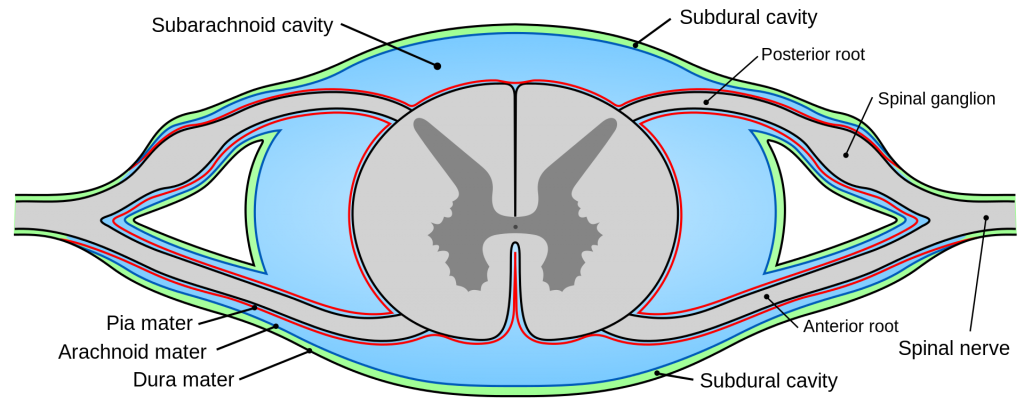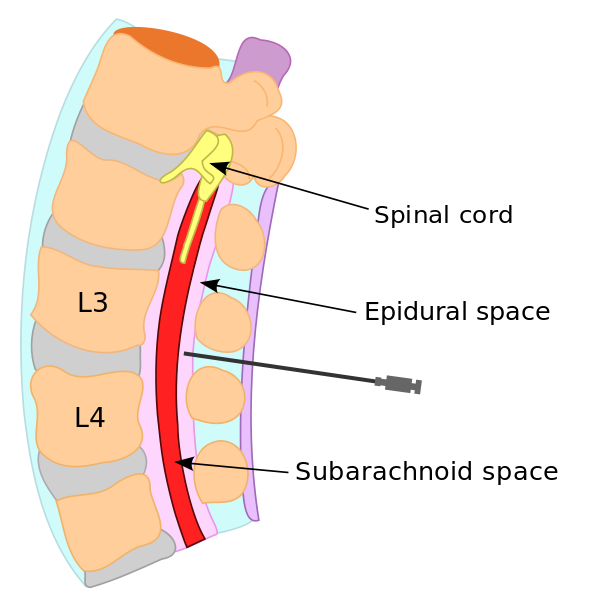
Anatomy
Head and Neck
A 21 year old student is sent in to ED by his GP with suspected meningitis. You are about to perform a lumbar puncture. Which of the following structures is normally penetrated in lumbar puncture:
Answer:
The cerebrospinal fluid (CSF) is located in the subarachnoid space, between the arachnoid layer and the pia mater. In a lumbar puncture, the needle penetrates the skin, fascia, supraspinous ligament, interspinous ligament, ligamentum flavum, epidural space, dura mater, subdural space, and arachnoid mater.Vertebral Canal
Anatomy / Head and Neck / Vertebral Column
Last Updated: 11th April 2019
The vertebral canal extends from the first cervical vertebra (C1) to the last sacral vertebra (S5).
Boundaries
Superiorly the vertebral canal is continuous, through the foramen magnum of the skull, with the cranial cavity.
The vertebral canal is bounded anteriorly by the vertebral bodies, intervertebral discs and the posterior longitudinal ligament, laterally by the vertebral pedicles and posteriorly by the vertebral laminae.

Relations of the Vertebral Canal. (Image by Unknown [Public domain], via Wikimedia Commons)
Contents
The vertebral canal contains the spinal cord and its protective membranes, together with blood vessels, connective tissue, fat and spinal nerve roots. The conus medullaris is the point below which the canal contains only the cauda equina and filum terminale.
Meninges
The spinal cord is surrounded by a series of three spinal meninges consisting of a dura, arachnoid and pia mater.
The bony walls of the spinal canal are separated from the meninges by the epidural (extradural) space.
The subarachnoid space, containing CSF, is found between the arachnoid and pia mater. The subarachnoid space around the spinal cord is continuous at the foramen magnum with the subarachnoid space surrounding the brain.

Meninges of the Spinal Cord. (Image by Mysid [Public domain], via Wikimedia Commons)
Lumbar Puncture
In adults, the spinal cord typically ends between L1/L2 whereas the subarachnoid space extends to approximately the lower border of vertebra S2. As a result of this, CSF can be withdrawn from the subarachnoid space in the lower lumbar region without endangering the spinal cord.
When performing a lumbar puncture, the needle passes between adjacent vertebral spinous processes, through the supraspinous and interspinous ligaments and through the ligamentum flavum to enter the extradural space. The needle then continues through the dura and the arachnoid mater to enter the subarachnoid space.
Layers penetrated during lumbar puncture:
- Skin
- Superficial fascia
- Supraspinous ligament
- Interspinous ligament
- Ligamentum flavum (first 'give')
- Extradural space
- Dura mater (second 'give')
- Subdural space
- Arachnoid mater
- Subarachnoid space (containing CSF)

Lumbar Puncture. (Image by Gurch [Public domain], via Wikimedia Commons)
Report A Problem
Is there something wrong with this question? Let us know and we’ll fix it as soon as possible.
Loading Form...
- Biochemistry
- Blood Gases
- Haematology
| Biochemistry | Normal Value |
|---|---|
| Sodium | 135 – 145 mmol/l |
| Potassium | 3.0 – 4.5 mmol/l |
| Urea | 2.5 – 7.5 mmol/l |
| Glucose | 3.5 – 5.0 mmol/l |
| Creatinine | 35 – 135 μmol/l |
| Alanine Aminotransferase (ALT) | 5 – 35 U/l |
| Gamma-glutamyl Transferase (GGT) | < 65 U/l |
| Alkaline Phosphatase (ALP) | 30 – 135 U/l |
| Aspartate Aminotransferase (AST) | < 40 U/l |
| Total Protein | 60 – 80 g/l |
| Albumin | 35 – 50 g/l |
| Globulin | 2.4 – 3.5 g/dl |
| Amylase | < 70 U/l |
| Total Bilirubin | 3 – 17 μmol/l |
| Calcium | 2.1 – 2.5 mmol/l |
| Chloride | 95 – 105 mmol/l |
| Phosphate | 0.8 – 1.4 mmol/l |
| Haematology | Normal Value |
|---|---|
| Haemoglobin | 11.5 – 16.6 g/dl |
| White Blood Cells | 4.0 – 11.0 x 109/l |
| Platelets | 150 – 450 x 109/l |
| MCV | 80 – 96 fl |
| MCHC | 32 – 36 g/dl |
| Neutrophils | 2.0 – 7.5 x 109/l |
| Lymphocytes | 1.5 – 4.0 x 109/l |
| Monocytes | 0.3 – 1.0 x 109/l |
| Eosinophils | 0.1 – 0.5 x 109/l |
| Basophils | < 0.2 x 109/l |
| Reticulocytes | < 2% |
| Haematocrit | 0.35 – 0.49 |
| Red Cell Distribution Width | 11 – 15% |
| Blood Gases | Normal Value |
|---|---|
| pH | 7.35 – 7.45 |
| pO2 | 11 – 14 kPa |
| pCO2 | 4.5 – 6.0 kPa |
| Base Excess | -2 – +2 mmol/l |
| Bicarbonate | 24 – 30 mmol/l |
| Lactate | < 2 mmol/l |

